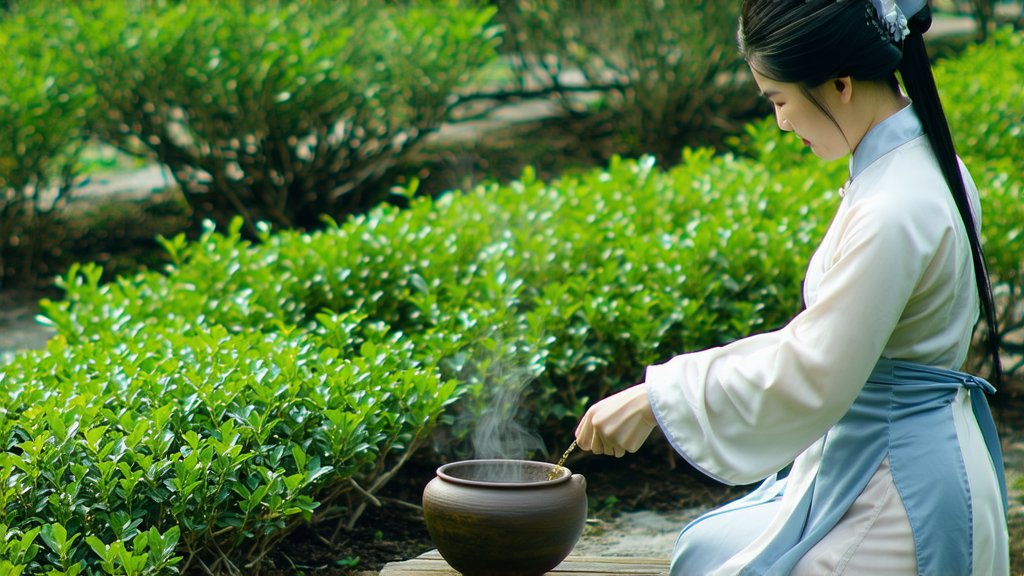
Fuding Dian Xin Bai Mudan, often referred to simply as "Bai Mudan," is one of the most esteemed varieties of Chinese white tea. Originating from the Fuding region in Fujian Province, Bai Mudan has a rich history that spans several centuries. This article aims to provide an in-depth exploration of its historical background, varieties, intricate production process, and unique methods of appreciation for international readers.
Historical Background
The origins of Bai Mudan can be traced back to the early Qing Dynasty (1644-1912). According to historical records, this variety was discovered accidentally by a local tea farmer named Cai Zuogong during the reign of Emperor Kangxi. While working in his tea garden, he noticed that certain tea plants had sprouted new leaves covered in fine, silvery hairs. Intrigued by their distinct appearance, he harvested these leaves and processed them using traditional techniques. The resulting tea had a delicate flavor profile unlike any other, leading to its classification as a new category within white tea.
Varieties
Bai Mudan primarily comes from two main types of tea plants: Da Bai (large white) and Xiao Bai (small white). Each type contributes unique characteristics to the final product.
-
Da Bai: These are large-leafed tea plants known for their robust growth and resilience. The leaves of Da Bai produce a stronger, more full-bodied infusion compared to Xiao Bai.
-
Xiao Bai: Smaller-leafed tea plants, Xiao Bai yield a more delicate and refined tea with subtle floral notes. The leaves of Xiao Bai are often used to create the finest quality Bai Mudan, prized for their exquisite taste and aroma.
Production Process
The production of Fuding Dian Xin Bai Mudan involves several meticulous steps, each contributing to its distinctive flavor and aromatic qualities.
-
Plucking: The first step involves selectively handpicking only the top two or three leaves and buds of the tea plant. This ensures that only the youngest and freshest parts of the plant are used.
-
Withering: After plucking, the leaves are spread out on bamboo mats under the shade to undergo natural withering. This process can take up to 72 hours and allows the leaves to lose moisture slowly while preserving their natural enzymes.
-
Drying: Once withered, the leaves are moved indoors for further drying. This is usually done using low-temperature ovens or sun drying to ensure that the leaves retain their essential oils and flavors.
-
Sorting and Grading: Finally, the dried leaves are carefully sorted and graded based on size and quality. Only the highest-grade leaves make it into premium Bai Mudan tea.
Appreciation Methods
Appreciating Bai Mudan goes beyond just drinking; it involves engaging all five senses to fully experience its elegance.
-
Visual Appreciation: Observe the dry leaves, which should be a mix of green and silvery-white. When brewed, the leaves will unfurl gracefully, revealing their delicate structure.
-
Aromatic Appreciation: Take a moment to inhale the fragrant aroma of Bai Mudan. Notes of jasmine, melon, and honey are commonly detected, providing a soothing olfactory experience.
-
Taste Appreciation: Sip the tea slowly to savor its smooth, mellow flavor. Bai Mudan is known for its balanced sweetness and slight vegetal undertones, making it a delightful experience for the palate.
-
Texture Appreciation: Pay attention to the mouthfeel of Bai Mudan. It should feel silky and slightly viscous, coating the mouth gently without any astringency.
-
Aftertaste: Finally, appreciate the long-lasting aftertaste that lingers on the palate. A good Bai Mudan will leave a clean, refreshing finish that invites you to take another sip.
In conclusion, Fuding Dian Xin Bai Mudan stands as a testament to the artistry and precision involved in Chinese tea culture. From its storied history to its intricate production process and multisensory appreciation methods, Bai Mudan offers a timeless journey into the world of white tea. For those seeking a refined and elegant tea experience, Bai Mudan is undoubtedly a perfect choice.